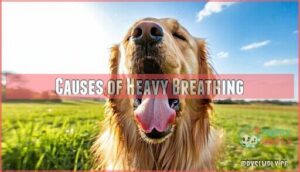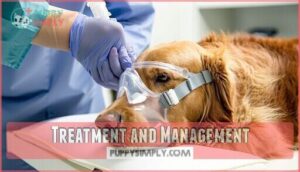This site is supported by our readers. We may earn a commission, at no cost to you, if you purchase through links.

Heavy breathing might point to issues like heart problems, infections, or even heatstroke.
Watch for other signs like coughing, restlessness, or pale gums.
Sometimes, it’s as simple as stress or overheating, but other times, it’s a red flag for conditions like heartworm or pneumonia.
If your pup seems uncomfortable or the heavy breathing happens at rest, don’t wait—call your vet.
Dogs can’t tell us what’s wrong, so it’s on us to notice.
Stay tuned for tips on keeping your furry friend breathing easy!
Table Of Contents
- Key Takeaways
- Dog Breathing Heavy
- Causes of Heavy Breathing
- Types of Breathing Difficulty
- Signs of Breathing Difficulty
- When to Seek Veterinary Care
- Diagnosing Breathing Difficulty
- Treatment and Management
- Preventing Breathing Difficulties
- Frequently Asked Questions (FAQs)
- Why does my dog breathe heavy when resting?
- What are the signs of respiratory distress in a dog?
- How to help a dog that is breathing hard?
- Why does my dog make a heavy breathing sound?
- Is Heavy Breathing in Dogs an Emergency?
- What Are the Types of Heavy Breathing in Dogs?
- What Causes Heavy Breathing in Dogs?
- How Do Vets Diagnose Heavy Breathing?
- What Treatments Are Available?
- What is Metabolic Acidosis?
- Conclusion
Key Takeaways
- Keep an eye on your dog’s heavy breathing, especially if it happens at rest, as it could signal serious issues like heart disease, lung infections, or heatstroke.
- Watch for warning signs like coughing, pale or blue gums, restlessness, or labored breathing, and act quickly by contacting your vet.
- Prevent heavy breathing by managing your dog’s weight, avoiding heat and stress, and scheduling regular vet check-ups.
- Treatments depend on the cause and might include oxygen therapy, medications, or surgery, so don’t delay seeking professional care.
Dog Breathing Heavy
When you notice your dog breathing heavier than usual, it’s often your pet’s way of signaling that something isn’t quite right with their health.
Heavy breathing in dogs is their way of saying, "Something’s off—pay attention to my health now.
Heavy breathing in dogs can stem from various causes, ranging from minor issues like excitement or heat to serious conditions such as heart failure, pneumonia, or airway obstructions that require immediate veterinary attention.
Left-Sided Congestive Heart Failure
The heart’s left ventricle struggles when mitral valve disease strikes, causing blood to leak backward instead of pumping forward.
This creates fluid overload in your dog’s lungs, leading to pulmonary edema and that telltale dog breathing heavy pattern you’re witnessing.
- Cardiomyopathy weakens heart muscle, making pumping blood increasingly difficult for your pet
- Pulmonary hypertension develops as pressure builds up in lung blood vessels over time
- Diuretics like furosemide help remove excess fluid causing your dog coughing and breathing issues
- Medication management requires strict adherence to prescribed heart medications and regular monitoring
Pain and Discomfort
Recognizing pain as a trigger for heavy breathing can save your dog’s life.
Abdominal pain from pancreatitis signs like vomiting often causes labored breathing patterns.
Injury impact creates chronic pain requiring immediate attention.
Your vet may prescribe analgesics, nonsteroidal antiinflammatories, or opioids for effective pain management, directly addressing the breathing difficulty’s root cause.
Pneumonia and Infections
If your dog struggles with rapid breathing, coughing, or lethargy, pneumonia could be the culprit.
Pneumonia in dogs often shows up as rapid breathing, coughing, or lethargy—don’t wait, act fast to protect their health.
It’s often caused by bacterial infections, fungal infections, or viral pneumonia.
Watch for:
- Heavy breathing paired with nasal or eye discharge.
- Symptoms like fever, fatigue, or appetite loss.
- Aspiration pneumonia from inhaling food or vomit.
Prompt vet care prevents complications like lung abscesses.
Bronchitis and Airway Issues
Chronic inflammation in canine bronchitis reduces airway elasticity, making breathing harder for your dog.
Airway conditions like bronchitis often cause coughing, wheezing, and discomfort.
Managing dog breathing problems involves minimizing environmental irritants and using bronchodilators for relief.
If airway inflammation persists, consult your vet for cough management strategies. Catching bronchitis early can prevent long-term airway issues and keep your pup comfortable.
Causes of Heavy Breathing
Heavy breathing in dogs can stem from a variety of causes, ranging from harmless panting to serious medical conditions.
Understanding these potential triggers helps you recognize when it’s time to seek veterinary care.
Heartworm Disease
Heartworm disease can cause heavy breathing as worms block blood flow between the heart and lungs.
Left untreated, it leads to lung damage and heart failure.
Stay proactive with these tips:
- Use heartworm preventatives like antiparasitic medication year-round.
- Monitor for disease progression with regular vet check-ups.
- Explore treatment options promptly to prevent long-term effects.
Prevention is always easier than treatment!
Pulmonary Edema
When heartworm disease stresses the heart, it can lead to pulmonary edema.
This condition causes fluid accumulation in the lungs, resulting in alveolar flooding and poor oxygen exchange.
Signs like dog labored breathing or respiratory distress shouldn’t be ignored.
Congestive heart failure often accompanies this, and treatments like diuretic use can help relieve symptoms and manage cardiac complications effectively.
Lung Cancer and Tumors
Lung cancer, though rare, can severely affect your dog’s breathing.
Metastatic lung cancer often spreads silently, complicating diagnosis. Tumor location impacts symptoms, with coughing, lethargy, and breathing complications being common.
Veterinary diagnosis, including imaging, helps pinpoint issues. Cancer treatment options like surgery or palliative lung care aim to improve life quality.
Early attention to dog lung problems is essential.
Upper Airway Conditions
Upper airway conditions like laryngeal paralysis, collapsed trachea, stenotic nares, or elongated palate often cause dog respiratory distress.
Brachycephalic syndrome, common in flat-faced breeds, can lead to stertor (snoring-like sounds) and dog noisy breathing.
If your dog’s breathing heavy or struggling, it might signal serious issues. Watch for signs of dog difficulty breathing and seek veterinary care promptly to address dog respiratory distress.
Types of Breathing Difficulty
Understanding the different types of breathing difficulties in dogs can help you recognize when something’s not right.
From rapid breathing to labored breaths, each pattern tells a story about your pet’s health.
Rapid Breathing
Rapid breathing, or a dog breathing fast, can signal trouble if their dog respiratory rate exceeds 30 breaths per minute at rest.
Emergency scenarios often stem from underlying causes like heatstroke, stress, or illness.
Watch for associated symptoms such as lethargy or pale gums.
Some breeds have a natural predisposition, but persistent rapid breathing always warrants a vet check to address potential underlying issues like illness.
Heavy Nose Breathing
Heavy nose breathing can signal trouble, especially if your dog’s flared nostrils, nasal discharge, or snorting sounds persist.
Watch for these signs:
- Snorting or wheezing during rest.
- Stuffy nose with facial swelling.
- Heavy breathing through the nose at night.
- Visible airway obstruction.
- Persistent nasal discharge.
Seek veterinary attention promptly to avoid complications and ensure your dog’s health, it is crucial to address heavy nose breathing issues.
Abdominal Breathing
If your dog’s abdomen pushes out during exhalation, it’s likely experiencing abdominal breathing, which signals respiratory distress.
This abnormal use of the diaphragm indicates reduced lung capacity, often linked to congestive heart issues or exhalation difficulty.
Watch for visible abdominal movement and labored breathing. If your dog is breathing heavy this way, seek immediate veterinary attention to guarantee proper care.
Labored Breathing
When your dog’s breathing seems like a workout, it’s likely labored breathing, a serious sign of respiratory distress.
Watch for:
- Wide-legged stance during breaths.
- Head held high or neck stretched.
- Visible chest and abdomen movement.
- Pale or blue gums (Emergency Signs!).
- Struggling to exhale, showing Muscle Fatigue.
These Breathing Mechanics issues demand immediate veterinary diagnosis to pinpoint causes of heavy breathing.
Signs of Breathing Difficulty
When your dog starts breathing heavily, it’s often a sign that something’s not quite right.
Recognizing symptoms like coughing, pale gums, or restlessness can help you act quickly and keep your pet safe.
Coughing and Wheezing
When your dog makes a wheezing sound or starts coughing, it could signal issues like bronchitis, asthma, or infections.
Pay attention to cough types—dry, wet, or hacking—as they help identify causes.
Wheezing sounds often indicate airway blockages.
Treatment options range from medications to home remedies like humidifiers.
Prevention tips include regular check-ups and avoiding irritants like smoke.
Restlessness and Anxiety
If your dog is breathing heavy and pacing, it might be showing dog stress signs linked to anxiety triggers like loud noises or separation anxiety.
Restlessness often pairs with heavy breathing, signaling canine anxiety.
Try calming techniques, such as soothing music or environmental changes, to ease their nerves.
Persistent anxiety may need behavioral therapy to help your furry friend feel secure.
Blue or Pale Gums
Blue or pale gums in your dog can signal oxygen deprivation, often tied to respiratory distress signs.
Watch for these changes:
- Pale gums may hint at anemia signs or shock.
- Blue gums (cyanosis) suggest severe breathing issues.
- Sudden gum color changes mean emergency action is needed.
- Persistent discoloration points to dog breathing difficulties requiring immediate veterinary care.
Always check gum color during heavy breathing episodes, as this can be a critical indicator of your dog’s health, potentially signaling respiratory distress.
Changes in Appetite
A sudden inappetence or selective eating can signal underlying health concerns.
If your pup shows a reduced appetite or food aversion, paired with lethargy or increased thirst, it’s time to investigate.
Dogs rarely skip meals without reason, so a decreased appetite might hint at dog health concerns like respiratory issues.
Don’t ignore these changes—they’re your dog’s way of saying something’s off, which could indicate a serious problem requiring immediate investigation.
When to Seek Veterinary Care
If your dog’s heavy breathing doesn’t ease with rest or seems out of the ordinary, it’s time to act quickly.
Knowing when to call the vet can make all the difference in keeping your furry friend safe and healthy.
Heavy Breathing at Rest
If your pup’s resting respiratory rate exceeds 30 breaths per minute, it could point to underlying lung problems or heart disease signs.
A heavy breathing dog at rest, especially with labored breathing or flared nostrils, isn’t normal.
Watch for a dog breathing heavily after no exercise—it’s a red flag.
Prompt care prevents worsening conditions.
Heavy Breathing at Night
When your furry friend starts breathing heavily at night, it’s worth paying attention. This could signal issues like cardiac night panting, sleep apnea, or even anemia signs.
Look for these red flags:
- Pacing or restlessness during the night.
- Nocturnal anxiety or whining.
- Gums turning pale or bluish.
- Heavy breathing dog with a stretched neck position.
Stay observant!
Sudden Onset of Panting
A dog panting excessively or showing dog rapid breathing out of nowhere can signal trouble.
Heatstroke signs, underlying conditions, or breed predisposition might be at play. If you notice dog open mouth breathing or even dog gasping for air, it’s time for emergency response.
Heavy breathing in dogs after minimal activity, like mild exercise intolerance, warrants immediate veterinary attention, as it can be a sign of heatstroke signs.
Reluctance to Eat or Drink
A decreased appetite or refusal to eat or drink could signal dehydration risks or an underlying illness.
Watch for these signs:
- Lethargy, vomiting, or inappetence alongside heavy breathing.
- Anxiety or stress causing appetite loss.
- Medication effects or nutrient deficiency.
Appetite stimulants may help, but always consult a vet if symptoms persist, as early care prevents complications, and it is crucial to address the issue promptly to avoid further health issues related to appetite loss.
Diagnosing Breathing Difficulty
When your dog’s breathing seems off, getting to the root of the problem is essential.
A thorough diagnosis often involves physical exams, X-rays, and specialized tests like echocardiography to pinpoint the issue.
Physical Examination
A physical examination helps pinpoint why your dog’s breathing seems off.
The vet checks mucous membranes for color changes, hydration assessment, and body condition.
Auscultation findings reveal lung or heart issues, while palpation techniques assess pain or swelling.
Here’s a quick look:
The examination includes checking for dehydration signs and assessing the dog’s overall body condition.
Chest X-Rays and Blood Tests
How can chest X-rays and blood tests help your pup? They’re essential for diagnosing why your dog’s breathing heavy.
- X-Ray Views: These show lung, heart, or airway issues.
- Bloodwork Panels: They detect infections or organ problems.
- Cost Considerations: Veterinary diagnostics vary, but catching issues early saves money—and stress.
Always discuss anesthesia risks and radiologist interpretation with your vet!
Echocardiography and Bronchoscopy
After chest X-rays, echocardiography helps evaluate heart function, especially for conditions like pulmonary hypertension.
If your dog’s breathing difficulties persist, a bronchoscopy might follow.
This procedure involves a small camera to inspect airways, often requiring anesthesia.
The table outlines the various diagnostic tools and their purposes, including heart assessment and airway inspection, which are crucial for determining the best course of action for your dog’s health.
Treatment and Management
When your dog’s breathing becomes heavy, prompt treatment can make all the difference.
From oxygen therapy to medications, your vet will guide you through the best options to manage their condition effectively.
Oxygen Therapy and Hospitalization
When breathing troubles become a pet emergency, oxygen therapy in a veterinary setting can stabilize your dog.
Hospitalization guarantees access to:
- Monitoring equipment for oxygen levels and heart rate.
- Oxygen delivery through masks or chambers.
- Post-therapy care adapted to recovery timelines.
Though hospitalization costs may vary, it’s often life-saving, giving your furry friend the best chance at recovery.
Medications and Diuretics
After stabilizing oxygen levels, medications like diuretics help reduce fluid buildup from pulmonary edema caused by congestive heart failure.
Heart medications may also be prescribed for long-term management. Watch for diuretic side effects, such as dehydration, and discuss dosage adjustments with your vet.
Consider purchasing dog diuretics if prescribed by your veterinarian. Medication interactions can occur, so always mention any alternative therapies or supplements your dog is taking to ensure safe management and avoid medication interactions.
Thoracocentesis and Surgery
If medications don’t ease your dog’s breathing difficulties, thoracocentesis or surgery might be necessary.
Thoracocentesis removes fluid from the chest cavity, offering quick relief. Surgery, like chest tube placement, tackles complex issues like lung tumors.
- Thoracocentesis Risks: Minimal but include infection.
- Surgical Options: Depend on severity.
- Post-Op Care: Strict rest required.
- Recovery Timeline: Weeks, not days.
Corticosteroids and Bronchodilators
Following surgical interventions, corticosteroids and bronchodilators often play a key role in managing respiratory issues.
Corticosteroids reduce inflammation, while bronchodilators ease airway constriction, helping dogs breathe easier.
Inhaled forms minimize steroid side-effects, making them safer for long-term use.
Combination therapy, pairing both medications, is common in veterinary medicine, and proper administration methods, like inhalers, facilitate effective treatment, especially for chronic conditions like bronchitis.
Proper administration methods are crucial for the success of the treatment, and combination therapy is a common approach in veterinary medicine.
Preventing Breathing Difficulties
You can help prevent your dog’s breathing issues by staying proactive with their health and daily care.
Simple steps like keeping them cool, stress-free, and at a healthy weight go a long way in ensuring they breathe easy.
Monitoring Health and Behavior
Keeping an eye on your dog’s daily habits can make a big difference.
Notice subtle changes in their behavior or breathing patterns? It might hint at something more.
Watch for:
- Behavioral changes, like restlessness or hiding.
- Appetite monitoring, ensuring they’re eating and drinking normally.
- Gum color and activity levels, checking for pale gums or unusual fatigue.
Consider using a breathing monitoring device for added security.
Stay observant, they’re counting on you!
Avoiding Heatstroke and Stress
After monitoring your dog’s health, watch for heatstroke and stress triggers.
Hydration strategies, like fresh water, and cooling techniques, such as shaded areas or cooling mats, help prevent overheating.
A great way to keep your dog cool is with a specialized cooling product.
Breed predispositions, like short-snouted dogs, make them more prone to panting in dogs during heat.
Address anxiety triggers with calming methods, reducing stress that can worsen heavy breathing or heat stroke risks.
Maintaining a Healthy Weight
A balanced diet and proper portion control are key to maintaining your dog’s healthy weight.
Pairing dietary guidelines with a consistent exercise regimen helps prevent obesity, a common cause of heavy breathing.
Weight monitoring is especially vital for breeds with predispositions to respiratory issues.
Whether it’s an older dog breathing heavily or a puppy breathing heavily, managing weight improves overall health and can prevent heavy breathing due to respiratory issues.
Regular Veterinary Check-Ups
A regular veterinarian visit isn’t just about shots—think of it as a tune-up for your dog’s health.
Veterinary examinations catch issues early, saving you stress and money in the long run.
Preventative care and dog health monitoring are especially important for breeds with breathing predispositions.
Consistent pet health monitoring guarantees your furry friend stays happy, even when life gets ruff, and this is crucial for their overall health.
Frequently Asked Questions (FAQs)
Why does my dog breathe heavy when resting?
Your dog’s heavy breathing at rest might signal stress, overheating, or a medical issue like heart disease or lung problems.
If it’s persistent or paired with other symptoms, a vet visit is essential.
What are the signs of respiratory distress in a dog?
When it rains, it pours—watch for labored breathing, pale or blue gums, flared nostrils, wheezing, or open-mouthed breathing.
If your dog struggles to breathe, stands stiffly, or collapses, seek a vet immediately.
How to help a dog that is breathing hard?
Keep your dog calm, cool, and in a well-ventilated area.
Offer water, but don’t force it.
Check for signs like pale gums or labored breathing, and contact your vet immediately if symptoms persist or worsen, which can be a critical situation.
Why does my dog make a heavy breathing sound?
Your dog’s heavy breathing could stem from stress, heat, or exercise, but it might also signal health issues like heart problems, respiratory infections, or pain.
If it persists, consult your vet for proper evaluation of the health issues.
Is Heavy Breathing in Dogs an Emergency?
Heavy breathing in dogs can be like a flashing red light—it often signals trouble.
If it’s labored, rapid, or happens at rest, contact your vet immediately, as it might indicate a serious medical emergency.
What Are the Types of Heavy Breathing in Dogs?
Heavy breathing in dogs includes labored, rapid, shallow, or stomach breathing.
Symptoms like flared nostrils, pale gums, or unusual noises (snorting, wheezing) often indicate medical issues.
Persistent heavy breathing warrants a vet visit immediately.
What Causes Heavy Breathing in Dogs?
Heavy breathing in dogs can stem from heart issues, lung infections, heatstroke, stress, or even breed traits like short snouts.
It’s often linked to discomfort, illness, or environmental factors, so always monitor closely.
How Do Vets Diagnose Heavy Breathing?
When vets diagnose heavy breathing, they pull out all the stops—examining your dog, running blood tests, X-rays, and even heartworm checks.
Advanced tools like CT scans or bronchoscopy help pinpoint the exact issue quickly.
What Treatments Are Available?
Treatments depend on the cause.
Options include oxygen therapy, medications like diuretics or antibiotics, or even surgery.
Your vet may suggest rest, lifestyle changes, or specific therapies to manage symptoms and improve your dog’s comfort.
What is Metabolic Acidosis?
Metabolic acidosis happens when your dog’s body produces too much acid or can’t remove it effectively, disrupting pH balance.
This condition often signals underlying issues like kidney disease, diabetes, or poisoning, requiring immediate veterinary attention.
Conclusion
Funny how dogs can’t just text you when something’s wrong, right?
Heavy breathing in your dog isn’t something to ignore—it could mean anything from heart issues to stress or overheating.
Pay attention to signs like coughing, restlessness, or pale gums, and don’t hesitate to call your vet if the heavy breathing happens at rest.
Staying proactive with regular check-ups, a healthy lifestyle, and quick action can keep your furry friend safe and breathing easy.
- https://www.aspcapetinsurance.com/resources/how-dogs-get-hernias/
- https://onlinelibrary.wiley.com/doi/10.1002/9781119414612.ch34
- https://www.akc.org/expert-advice/health/treating-dog-anxiety/
- https://pets.webmd.com/dogs/dog-panting-heavily
- https://www.vets-now.com/pet-care-advice/breathing-problems-and-difficulties-in-dogs/



















